Pocket Picks Value: The Ultimate Guide to Quality EDC Choices
Updated On: October 26, 2025 by Aaron Connolly
Defining Pocket Picks Value

A pocket pick earns its value by coming through when you need it most. It should deliver great results for its cost and be practical for everyday use.
You can spot value by looking at how well it performs, how much it costs, and whether it stands up to daily life.
What Makes a Pocket Pick Valuable?
The best pocket picks show up when it counts. In gaming, that means picking champions or strategies that work even if they’re not the trendy choice.
For EDC gear like pocket knives, value comes from reliability and versatility. A blade that stays sharp through daily tasks beats expensive gear that lets you down.
Key value indicators include:
- Consistent performance in different situations
- Surprising your opponent or handling unexpected jobs
- Needing little maintenance
- Adapting to whatever comes up
The top pocket picks usually don’t get a lot of hype. They’re not flashy, but they work when you need them.
It’s better to have something that works 90% of the time than a perfect pick that’s only reliable half the time.
Cost Versus Performance Factors
Value pops up in the gap between what you pay and what you get. The sweet spot is finding gear that gives you more than you expected.
Budget pocket knives in the £20-40 range often deliver almost everything a £100+ model does. That’s why they’re so popular with most folks.
Performance-to-cost analysis:
| Price Range | Performance Level | Best For |
|---|---|---|
| £15-30 | Basic reliability | Occasional use |
| £30-60 | Solid everyday performance | Regular users |
| £60-120 | Professional grade | Heavy daily use |
Think about the total cost over time. A £50 knife that lasts five years actually costs less than buying three £20 knives that break every year.
Most categories have a price ceiling. After a certain point, you’re just paying for fancy materials or a name.
Evaluating Build Quality
Build quality decides if your pocket pick is a long-term win or a letdown. Pay attention to materials, construction, and how it holds up in the real world.
Critical quality markers:
- Steel quality affects how long the edge lasts and how sharp it stays
- Lock mechanisms need to engage solidly, no wiggle room
- Handle materials should grip well, even when wet
- Pivot smoothness shows off good manufacturing
Tight tolerances make a huge difference. When parts fit right, your knife feels better and lasts longer.
Field testing tells the real story. Something that feels sturdy in the shop might loosen up after a few weeks.
Quality control isn’t always consistent, even with big brands. It’s worth checking each item yourself.
Heads up: Skip anything with uneven grinds, loose screws, or sharp, unfinished edges.
Key Pocket Knife Types for Value
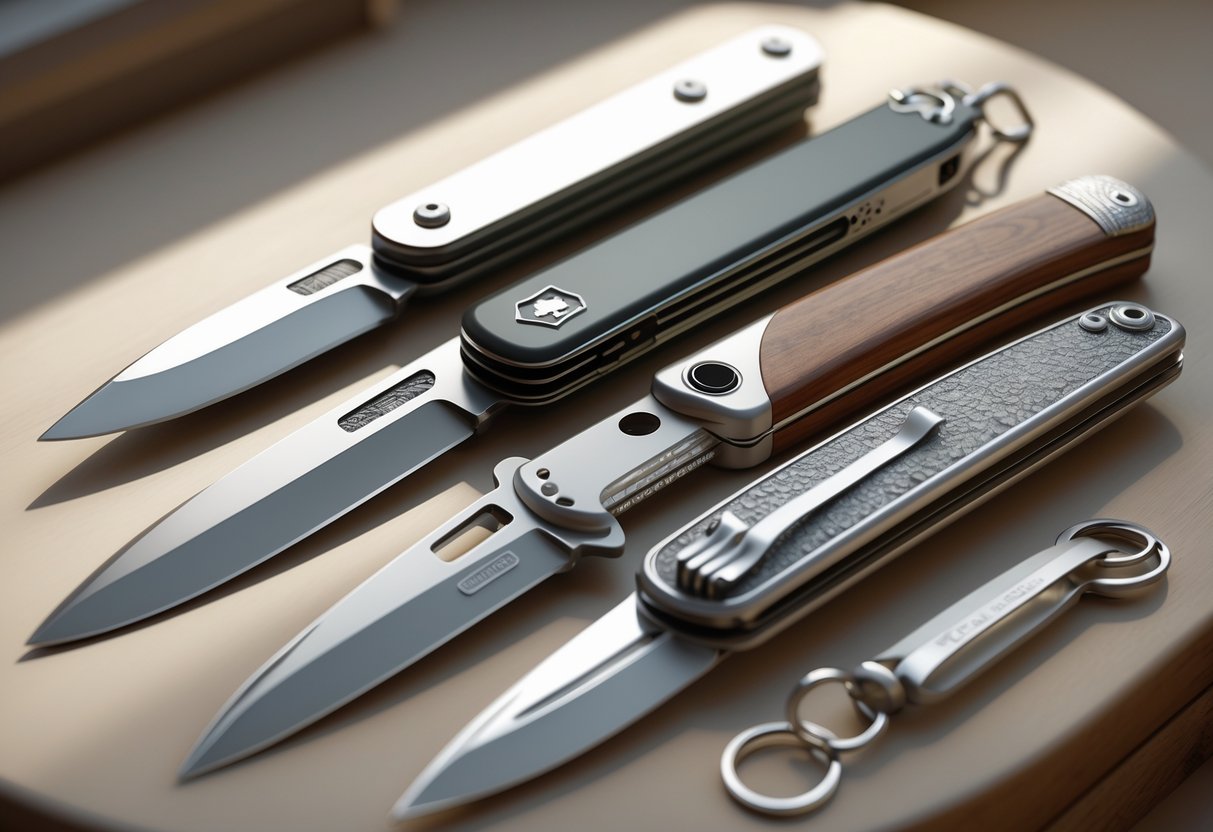
Different knife mechanisms change how a pocket knife performs and how well it holds value. Your locking system choice affects how easy it is to use and how much it’s worth down the road.
Flipper Tab Folding Knives
Flipper tab knives open with a little metal tab at the blade’s base. You just push it with your finger to flick the blade open.
These knives really took off in the 2000s and now they’re everywhere. A smooth flipper action is something collectors love.
Most flippers use either ball bearings or washers. Ball bearings make for a slicker open, but they’re pricier. Washers last longer if you use your knife hard.
Key value factors include:
- Blade steel (S30V, S35VN are worth more)
- Tight manufacturing (no blade wiggle)
- Brand reputation (Benchmade, Spyderco tend to hold value)
Premium flippers usually keep 60-70% of their value. Cheaper ones under £50 lose value fast. Mid-range options (£80-200) hit the best mix of quality and value.
Button Lock Varieties
Button lock knives open and close with a spring-loaded button. You press it to fold the blade; it’s simple and secure.
Button locks started with Italian switchblades but now show up in modern folders. Their mechanical complexity can make them more valuable over time.
Good button locks need tight tolerances. Bad ones get sticky or won’t lock. Well-made versions last for decades.
Valuable button lock features:
- Titanium or steel bodies (not aluminium)
- Smooth, precise button movement
- No gritty feeling in the pivot
Vintage button locks from Microtech or Protech fetch high prices. Newer ones start around £150 if you want quality. Italian-made versions can run £200-400 but rarely lose value.
Liner Lock Choices
Liner lock knives have a thin metal strip inside the handle that snaps behind the blade when open. You push it aside to close.
This lock style got big in the 1980s thanks to Michael Walker. Liner locks are reliable and usually cheaper to make.
The liner’s material and heat treatment matter. Titanium liners are springy and resist rust. Steel liners are cheaper but can wear out.
Quality indicators include:
- Liner grabs 30-50% of the blade tang
- Lock-up is solid, no wiggle
- You can close it without awkward hand moves
Entry-level liner locks start at £30 but don’t hold value. Mid-range models (£60-150) from trusted brands keep their price better. Custom liner locks from well-known makers can actually go up in value.
Frame Lock Knives and Value
Frame lock knives stand out for value because the handle itself locks the blade. They’re stronger than liner locks and start at about £30-50 for solid budget models.
Premium versions last for years of daily carry.
Frame Lock Mechanisms Explained
The frame lock uses part of the handle to hold the blade open. Chris Reeve came up with this as a tougher version of the liner lock.
When you open the blade, the handle flexes in and locks against the blade’s base. This makes for a rock-solid lock.
Key advantages include:
- Stronger build – the whole handle supports the lock
- Metal-on-metal – keeps the blade secure
- Fewer parts – less to break down
Handle material changes the feel. Steel frames are tough and cheap. Titanium costs more but is lighter and shrugs off rust.
Frame locks usually feel more secure than liner locks. The thick metal spreads out the pressure when you’re really using the knife.
Best Budget Frame Lock Options
Decent frame lock knives start at about £30-50. Stick with brands that have a good track record.
Budget considerations:
- Steel handles keep the price low
- Entry-level blade steels like 8Cr13MoV work fine
- Simple designs mean fewer things to go wrong
Kershaw, CRKT, and Gerber all make solid budget frame locks. You get sturdy builds without paying a fortune.
Check for smooth opening and a confident lock-up. The frame should snap in with no blade wobble.
Avoid super-cheap knives under £20. They usually use poor steel or flimsy frames. Spending a bit more pays off in the long run.
Think about what you’ll use it for. Shorter blades (7-9cm) are great for most tasks. Longer blades fit better for outdoor stuff.
Multi-Tools: Adding Versatility to Your Pocket Picks
Multi-tools cram a bunch of functions into one compact package. They’re a great value for daily carry, especially if you like being ready for anything.
Popular Multi-Tool Functions
The best multi-tool features solve everyday problems. Pliers top the list—they grip, twist, and pull.
Sharp blades take care of cutting jobs, from boxes to emergencies. Most multi-tools have a main blade and maybe a smaller one.
Must-have tools on a good multi-tool:
- Wire cutters for quick fixes
- Flathead and Phillips screwdrivers
- Scissors for those little jobs
- Bottle and can openers
- File for smoothing things out
Hex keys are handy for bikes and furniture. Many tools include 4mm and 5mm sizes.
Some fancy models add bit drivers or wire strippers. Not everyone needs those, but they’re nice if you do.
When a Multi-Tool is the Best Value
Multi-tools shine when you need several tools often. They’re perfect for outdoors or when you want to keep things light.
Multi-tools work best for:
- Camping or hiking
- Bike repairs
- Quick home fixes
- Work situations with changing needs
If you only use one tool, get a dedicated version. A real knife usually beats a multi-tool blade for tough jobs.
Multi-tools range from £15-150. The sweet spot is usually £40-60 for good quality and enough features.
Look for ones with blade locks to keep your fingers safe. Pocket clips help you carry them without a bulky keychain.
Top Pocket Knife Brands for Value Hunters
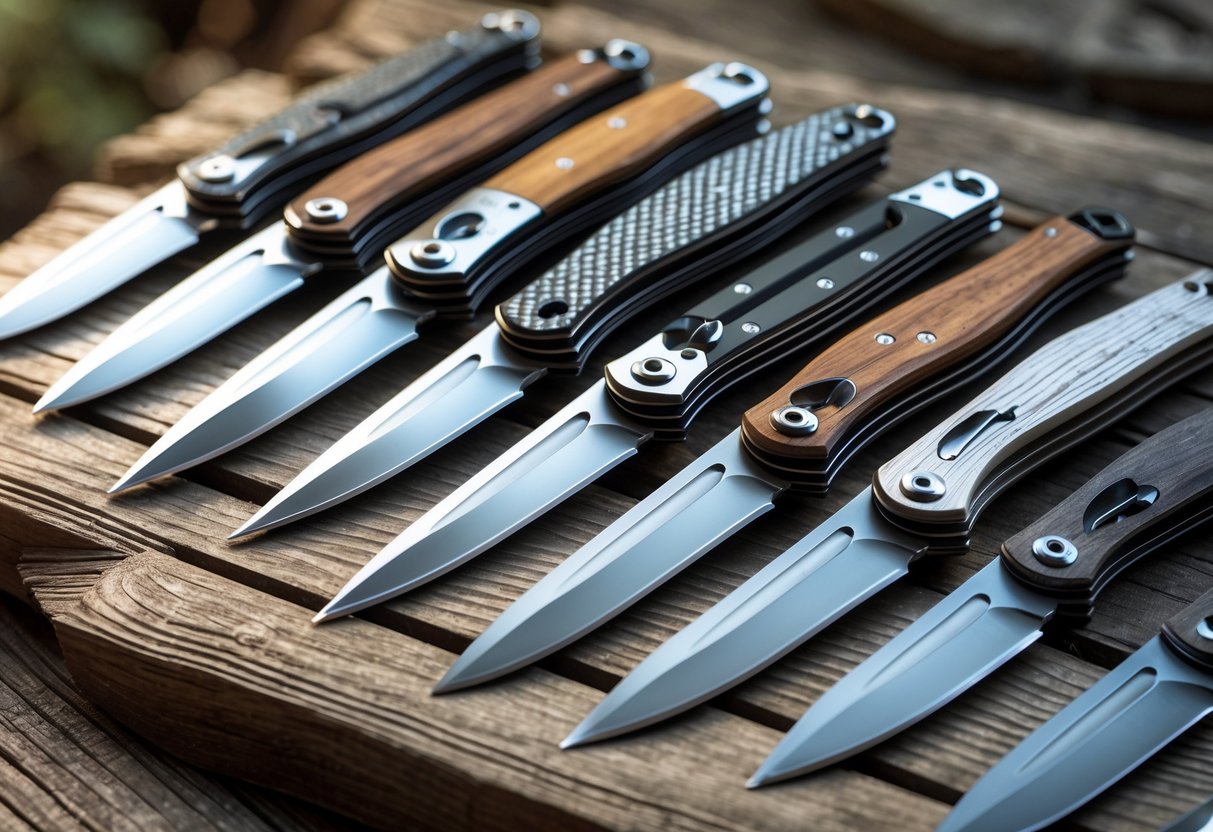
You don’t have to spend a fortune for premium features. These four brands keep impressing with quality, smart designs, and reliability at fair prices.
Benchmade’s Affordable Series
Benchmade made its name with high-end tactical knives. But their budget line still brings the quality you’d expect from Oregon.
The Bugout series is a standout for value. At about £120, you get S30V steel and a super-light build. The Grivory handles feel sturdier than you’d think.
Key features that matter:
- AXIS lock for smooth, one-handed use
- Deep-carry pocket clip
- Free lifetime sharpening
- Made in the USA
The Mini Bugout shrinks things down for office carry or places with blade limits.
Benchmade’s warranty is solid. They’ve replaced knives with worn screws or bent clips for us, no hassle.
Kershaw Leek and Its Rivals
The Kershaw Leek changed the game for slim EDC knives. Even after all these years, it’s still one of the best deals out there.
For £45-60, the Leek gives you 14C28N steel and a solid frame lock. It’s slim enough to disappear in your pocket.
What makes it special:
- Assisted opening for fast action
- Reversible pocket clip
- Super-thin profile
- Lots of handle options
Competition’s heating up: CIVIVI’s Elementum is close in size and has better steel for a bit more. QSP Penguin is another strong rival with a different look.
The Leek’s weak spot is its tip—it can snap if you pry too hard. But for slicing, it’s hard to beat.
Pro tip: Go for the blackwash finish. It hides scratches way better than the shiny one.
CRKT’s Top Picks
Columbia River Knife & Tool really leans into innovative designs without breaking the bank. They team up with custom makers, so you get a taste of high-end concepts—even on a budget.
The M16 series helped make flipper deployment popular in affordable knives. For around £35, you get solid build quality and reliability that’s stood the test of time.
CRKT stands out for variety:
- Classic looks (Squid, Pilar)
- Tactical choices (M16, M21)
- Oddball mechanisms (Crossbones, Homefront)
- Designer collabs
The CEO is a good example of their creative side. It’s slim, almost pen-like in your pocket, and the 8Cr13MoV steel keeps costs down while still performing well enough for most tasks.
Some quality notes: CRKT keeps prices low by manufacturing overseas. Fit and finish can be hit or miss. Always check the pivot tightness when your new knife arrives.
Their Pilar feels great in hand for £40. The curved handle just fits. On some versions, Veff serrations make short work of rope and fabric.
CIVIVI’s Rising Value
CIVIVI’s a newer name, but wow—they’ve already made a mark by packing premium features into mid-range prices. Every knife comes with ball bearings and decent steel.
The Elementum became a classic almost overnight. For £55-70, you get:
- Premium steel choices (S35VN, Damascus)
- Smooth ball bearing opening
- Lots of handle options
- Consistently good quality control
Here’s what makes CIVIVI different: They throw in features you’d expect on knives over £100. Ceramic bearings, titanium scales, and fancy steels are pretty standard here.
The Brazen brings a button lock to the £60 price point—something you used to only see on expensive custom knives.
Build quality? Lockup feels solid across the board. Blades stay centered, even after months of use. Their pocket clips hold tight but don’t tear up your handles.
New models like the Merit offer Damascus steel without the crazy price tag. They give you tons of handle options, so you can actually match your own style.
Blade Shapes and Materials
Blade shape and steel choice can make or break your budget pocket knife. Drop-point blades are everywhere because they just work for most daily stuff. Steel quality in cheap knives has gotten way better in the last few years.
Drop-Point Blade Advantages
Drop-point blades show up on most value knives because they’re so versatile for cutting tasks. The spine curves down to meet the edge, which gives you a strong, controllable tip.
You get great tip control for detail work. The lowered point helps you avoid accidental punctures—handy for opening boxes or slicing up lunch.
The broad belly gives you plenty of edge for slicing. Whether you’re prepping food or cutting rope, drop-points handle it.
Why people love them:
- Tip’s tough and hard to snap
- Lots of cutting edge for slicing
- Simple to sharpen and maintain
- Handles almost all daily jobs
Brands like CIVIVI and Real Steel stick with drop-points because they’re practical and cheap to make. You’ll spot them on knives from £20 up to £100.
Other Common Blade Profiles
Sheepsfoot blades come with a straight edge and a spine that drops off sharply. No sharp point means fewer accidents—great for utility work.
The QSP Penguin uses this style well. Sheepsfoot blades slice and scrape like champs but don’t pierce as easily.
Tanto blades have a sharp angle where two edges meet, which gives you a super strong tip for tough piercing jobs.
Sharpening tantos is more of a pain since you deal with two edge angles. They’re not as common in cheap knives because they’re harder to make.
Clip-point blades have a concave cutout on the spine, making a fine, sharp tip. They’re perfect for precision, but that tip can snap under stress.
Blade Steel Quality in Value Picks
Budget knives now use steels that would’ve been called premium not too long ago. Chinese makers really nailed steels like D2 and 14C28N, so you get solid performance for less.
Stainless steels like 14C28N fight off rust and keep a decent edge. They’re great for everyday carry—you won’t have to baby them with oil.
Carbon steels like D2 hold an edge longer but need more care to avoid rust. They’re worth it if you do a lot of tough cutting.
K110 steel pops up in knives like the Petrified Fish Hourglass. It holds an edge well and doesn’t cost much. Performs surprisingly close to pricier steels.
Heat treatment is the real game-changer. Good heat treatment makes even cheap steel work well, while bad treatment ruins expensive stuff. Budget brands are finally getting this right.
Everyday Carry Considerations
Your everyday carry setup can really affect how much you use your pocket tools. Weight, clip design, and how visible your gear is all play a part in whether you’ll carry it or leave it at home.
Weight and Portability
Every gram adds up when you’re carrying gear all day. Most folks start to feel the weight once they hit 100 grams, so try to keep your whole setup under that.
Lighter material picks:
- Titanium tools (about half the weight of steel)
- Knives with carbon fibre scales
- Aluminium multi-tools
- Polymer handles
We suggest tossing your current pocket stuff on a scale. It’s easy to underestimate how heavy it gets with a fat wallet, chunky phone, keys, and a steel knife—200 grams sneaks up fast.
Switch up your carry for different days. Office days might be fine with heavier tools, but if you’re out and about, lighter is better. Some people even keep separate “work” and “weekend” kits.
Pocket Clip Designs
The pocket clip decides how secure and easy to grab your tool is. Deep carry clips hide most of the tool in your pocket—less flashy.
Clip placement matters:
- Tip-up: Handle’s easy to grab, fast to open
- Tip-down: Safer, blade stays tucked away
- Ambidextrous: Move it to either pocket
Metal clips outlast plastic, but they can scratch your phone. Titanium clips seem to get the best mix of toughness and not scratching up your stuff.
Some clips are so tight they shred your pockets. Others are too loose and you lose your tool. Try out new clips before trusting them.
Discreet Carry Options
You don’t want your EDC drawing the wrong kind of attention, especially at work or in public. Bright colors and tactical looks can make tools seem more aggressive than they are.
How to keep things low-key:
- Matte black or grey finishes
- Little or no branding
- Classic styles over tactical looks
- Smaller sizes that hide well
Think about where you’ll use your tools. Offices usually call for more subtle gear than a workshop. Luckily, lots of good tools come in both “tactical” and “gentleman’s” versions.
Some tools look like money clips or pens, which really helps in formal settings. Those designs work when a regular pocket knife would stand out.
Safety Features and Locking Mechanisms
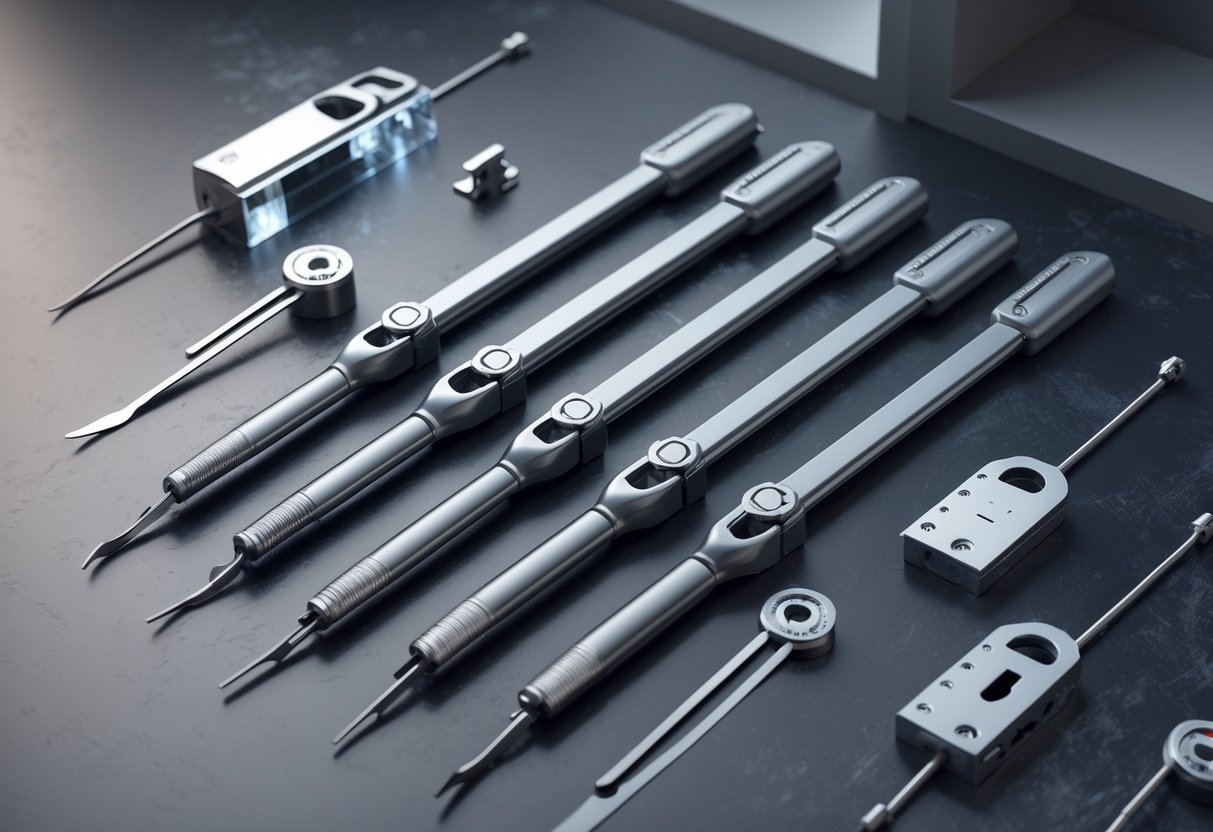
Lock types can change how safe and easy your knife is to use. Button locks are super beginner-friendly, while liner and frame locks give you reliable security for daily carry.
Comparing Lock Types
Button Lock knives use a spring-loaded post that pops through the handle. You just push the button to unlock the blade. Your fingers stay well away from the edge while closing.
Button locks offer the safest operation for people new to knives. There’s no need to put your hand near the sharp part when closing.
Liner Lock knives have a thin metal liner inside that snaps behind the blade when open. To close, you push the liner aside with your thumb.
Frame Lock knives do the same thing, but the whole handle frame acts as the lock. This makes it stronger, since there’s more metal holding the blade. Usually, it’s titanium or steel that flexes to lock and unlock.
Both liner and frame locks bring your thumb closer to the blade when closing. With good technique, it’s safe, but beginners might need to practice.
Safety Benefits for Everyday Use
Button locks work great for the workplace or in public since they’re so easy to use. Just push the button and you’re done—no fuss, no risk.
You can see the button sticking out when the blade’s locked open. When you press it, the button sits flush, so you know it’s ready to close.
Liner and frame locks are usually slimmer because they don’t need a button mechanism. They also tend to be stronger for tough jobs.
Still, they do make you put your thumb closer to the blade’s spine. New users sometimes get nervous or use the wrong closing technique.
If you’re giving a knife as a gift or introducing someone to pocket knives, button locks make life easier. It’s almost impossible to mess up.
Value by Use Case

Not every pocket knife fits every job, and what counts as “value” really depends on how you’ll use it. Urban folks, outdoor fans, and collectors all look for different things.
Urban Versus Outdoor Use
Urban pocket knives focus on convenience and daily chores. You want something small that opens packages, cuts rope, or handles quick repairs.
For city carry, £15-40 gets you a solid knife—look for blades under 3 inches. Lightweight and a pocket clip matter more than fancy steel.
- Slim build
- One-handed opening
- Pocket clip
- Non-threatening look
Outdoor knives need to be tough. We suggest spending £40-120 if you’re going to use it for real outdoor work.
Full-tang construction is a must. Go for 4-5 inch blades that can chop wood or prep camp meals. Weight takes a back seat to strength here.
Outdoor essentials:
- High carbon steel
- Full tang design
- Bigger blade (4-5 inches)
- Comfy grip for long use
Work-Ready Pocket Picks
Trade workers need knives that can handle abuse. Construction, electrical, and maintenance jobs will destroy cheap knives fast.
Plan to spend £30-80 for a work knife you can trust. You’ll probably need to replace it every year or two, depending on how hard you use it.
Work knife checklist:
- Replaceable blades
- Locking system
- Rust resistance
- Easy to sharpen
Utility knives with replaceable blades are a bargain for trades. Ten new blades cost £5-10.
Fixed-blade work knives last longer but cost more upfront—expect £50-100 for a good one.
A lot of tradespeople carry two knives: a cheap utility for rough jobs and a nicer folder for precision.
Collectors and Vintage Value
Collectors care about rarity, condition, and who made the knife. Case pocket knives are huge in the vintage scene.
Pre-1940 Case knives can fetch £200-2,000 depending on style and condition. More common ones from the 1960s-80s usually go for £20-150.
What affects collector value:
- Year made
- Pattern rarity
- Handle material
- Condition
- Tang stamps
Case knife databases track over 25,000 sales with details. Check these before buying or selling old knives.
Condition usually matters more than age. A mint 1970s knife can be worth more than a beat-up 1930s piece.
Modern limited editions rarely keep their value like true vintage knives. Buy current models to use, not as investments.
Caring for Your Value Pocket Pick
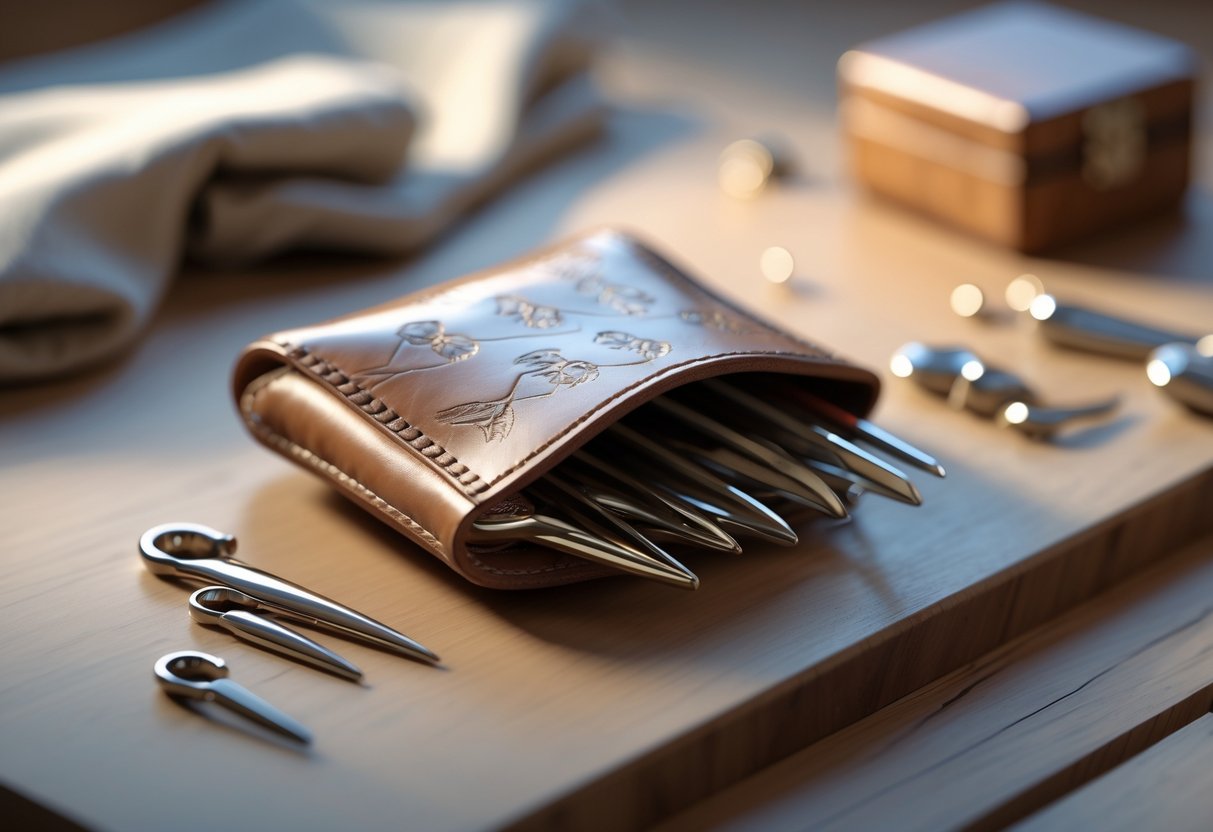
If you take care of your pocket pick, it stays sharp longer and works better when you actually need it. Regular cleaning stops rust and damage, and using the right sharpening techniques keeps the blade useful for years.
Cleaning and Maintenance Basics
I always clean my pocket pick after every use to keep dirt and moisture from building up. Just wipe the blade with a dry cloth right away.
When it needs a deeper clean, I use warm water and a bit of mild soap. I avoid harsh chemicals—they can mess up the handle or ruin the blade’s finish.
Weekly cleaning routine:
- Take apart any removable parts
- Clean each piece on its own
- Dry everything completely before putting it back together
- Rub a thin layer of oil on moving parts
I pay extra attention to the pivot point since dirt loves to hide there. A cotton swab works well for those tight spots.
I store my pocket pick somewhere dry, since moisture leads to rust and corrosion fast. Throwing a silica gel packet into the storage container helps too.
Warning: Don’t ever toss your pocket pick in the dishwasher. The heat and detergents will wreck both the blade and the handle.
Sharpening and Upkeep
A sharp pocket pick just works better and, honestly, is safer than a dull one. I check sharpness once a month with the paper test—super simple.
Basic sharpening steps:
- Grab a sharpening stone (400-1000 grit is good)
- Stick to the original angle (usually 20-25 degrees per side)
- Use smooth, even strokes from heel to tip
- Finish up with a higher grit stone (3000-8000)
I start with light pressure and only add more if needed. If you press too hard, you’ll strip away too much metal and shorten the blade’s life.
Ceramic and carbide sharpeners are handy in a pinch, but they eat up the blade faster than whetstones. I save those for emergencies.
Quick tip: After each use, I strop the blade on leather to keep the edge keen between proper sharpenings.
If sharpening makes you nervous, pros usually charge £5-15 and do a solid job. Sometimes it’s worth it to let them handle it.
Repairing and Replacing Parts
Most pocket pick repairs come down to the locking mechanism or the pivot. Loose screws make the blade wobble and that’s just asking for trouble.
Common repair issues:
- Pivot screws coming loose
- Lock springs wearing out
- Blade tips getting damaged
- Handles cracking
I tighten screws slowly and use the right size screwdriver. If you overtighten, you can strip the threads or make the blade hard to open.
You can find replacement parts for good brands like Spyderco and Benchmade. The manufacturer’s site usually has genuine components.
If you crack a G-10 or carbon fibre handle, repairs rarely work well. Expect to pay £20-50 if you want a pro to replace the handle.
When to replace entirely:
- Blade damage close to the tang
- Liners with cracks
- Major handle breaks
- If repairs cost more than 60% of the original price
I keep track of maintenance and repairs. If you care for your pocket pick, it can last a lifetime—sometimes even longer.
Up-and-Coming Value Brands and Models

Some new brands are really stepping up, offering impressive quality at prices that don’t sting. Even some old names are dropping models with premium features, minus the premium price.
Emerging Value Champions
Stuhrling Original stands out for skeleton-style pocket watches. Their watches usually have gold-toned, numberless dials, 6-10 jewels, and sturdy stainless steel frames with yellow-gold or brass finishes.
You get 30-35 hour winding systems and chrome-plated gears. For £200-400, that’s a sweet spot for collectors who love seeing the mechanical guts.
Charles-Hubert is another rising star with Swiss quartz movements and chunky 47mm hunter cases. Dual skeleton dials and automatic winding make these feel high-end at £1,000-1,200.
I especially like their Arabic-lettered dials with curb chains. Their composite materials develop a cool patina over the years.
Desperado has made a name for itself by matching the quality of pricier brands. Their models often outperform watches that cost twice as much, which is great for folks just starting out.
Hidden Gems to Watch
Kronen & Sohne brings German engineering to the table at prices that won’t break you. Their mechanical dials show off exposed gears and gold accents, usually running £500-1,000.
I’d look for pieces with etched serif numerals and a signed logo on the face. You’ll get a factory warranty card too, which is a nice touch.
Longines vintage pieces are a real find. Their three-dial sports watches with rose-gold finishes and the winged hourglass logo range from £500 to £5,000.
If you can snag a railroad model with coppery cases and 60-second markings, you’re getting a real slice of Swiss history and craftsmanship.
Frederique Constant from the 1980s mixes reliability with old-school looks. Their plated frames and modern movements hold up better than a lot of true vintage stuff.
Buying Advice and Final Considerations
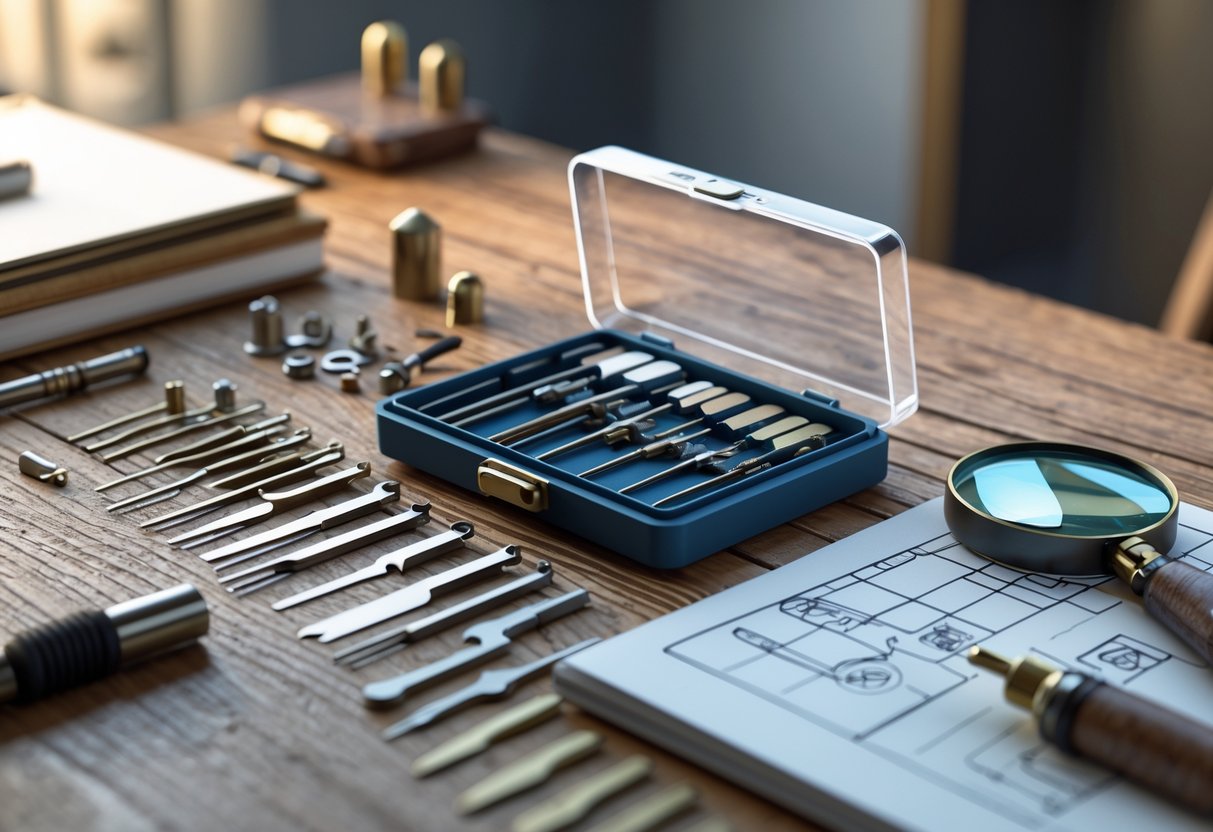
If you want the best value on pocket picks, you need to know where to look—and what to avoid. Smart shoppers always check warranty terms before buying, just in case.
Where to Find the Best Deals
In my experience, the best deals come from comparing a few sources. Online shops usually beat brick-and-mortar prices, but timing matters too.
Best places to shop:
- Amazon and eBay – Huge selection and loads of reviews
- Specialist knife retailers – Staff know their stuff and can answer questions
- Manufacturer websites – Direct sales and the latest releases
- Outdoor gear shops – Good if you want to handle before buying
Black Friday and end-of-season sales can knock 20-30% off the price. Many stores will also price-match if you spot a better deal elsewhere.
Sign up for email alerts from your favorite brands. They’ll send exclusive discount codes straight to your inbox.
Before you buy, read reviews and check out forums. Real user feedback helps you spot the steals and avoid the duds.
Avoiding Common Pitfalls
I’ve seen new buyers make some costly mistakes. The worst? Going for the absolute cheapest pick without thinking about long-term costs.
Common mistakes to watch for:
| Mistake | Why It’s Costly | Better Approach |
|---|---|---|
| Buying ultra-cheap imports | They break fast, poor materials | Spend £15-25 for something reliable |
| Ignoring blade steel type | Dulls quickly, tough to sharpen | Go for 440C or 8Cr13MoV at least |
| Not checking return policies | You’re stuck with bad buys | Only buy with a 30+ day return window |
People also buy knives that are way too big for daily use. A 4-inch blade might look cool, but it’s not practical for most folks.
Skip the flashy designs. Bright colors and wild patterns often hide lousy construction.
Always read the fine print on “lifetime warranties.” Some only cover defects, not normal wear or user mistakes.
Warranties and Customer Support
A good warranty protects your wallet and shows the company stands behind their product. I always check this before pulling the trigger.
What to look for:
- At least a 1-year warranty on defects
- Free repair or replacement when things go wrong
- Responsive customer service—phone or email should work
- Easy-to-understand terms (no legal maze)
I like to test customer service ahead of time. I’ll send a simple question just to see if they actually respond.
Save your receipt and register your purchase if you can. It makes warranty claims a breeze.
Some brands throw in lifetime sharpening or repair programs, which is a real perk if you plan to use your knife a lot.
Budget brands might skimp on support, but big names like Victorinox or Benchmade usually honor warranties with no fuss.
Frequently Asked Questions

Draft pick valuation in fantasy football mostly comes down to trade charts and analytical tools that assign point values to each pick. Most calculators start with the Jimmy Johnson chart, but newer ones factor in positional scarcity and league rules.
How can I accurately calculate the value of draft picks in fantasy football?
I’d start with the Jimmy Johnson trade chart. That system gives 3000 points to the first pick, 2600 to the second, and so on.
For dynasty leagues, you have to tweak values for your format. Does your league use PPR? Superflex? IDP? Adjust accordingly.
Most fantasy platforms now have built-in calculators. ESPN, Yahoo, and Sleeper all offer trade evaluators that use your league’s settings.
What’s the most efficient way to assess future NFL draft pick values?
Future picks usually lose 5-10% of their current-year value because there’s more uncertainty. So, a 2025 first-rounder might equal an early second-rounder in 2024.
I use the “standard depreciation” rule—next year’s pick drops down a grade (first becomes second, second becomes third).
Always consider your roster needs and team outlook. If a rebuilding team trades a future first, there’s more risk than if a contender does.
Can you suggest a reliable NFL trade value calculator?
The Jimmy Johnson chart is still the go-to for draft pick trades. You can find free calculators at Fantasy Football Calculator and Dynasty League Football.
If you want something more advanced, check out the Rich Hill model or Fitzgerald-Spielberger chart. These look at salary cap and modern positional values.
I like mobile-friendly calculators during live drafts. You just plug in the picks and compare point values on the fly.
What principles guide the creation of a draft pick value chart?
Draft charts start with the idea that early picks are worth way more than later ones. The gap between picks 1 and 10 is much bigger than between 20 and 30.
Modern charts boost values for positions with scarcity. Quarterbacks and running backs, especially in superflex or PPR leagues, get a bump.
History shows most stars come from early rounds. Charts reflect this by heavily weighting the top picks and dropping late-round values a lot.
Is there a tool to help determine trade values for NFL picks?
Yep, tons of free online calculators use the classic trade charts. The most popular ones let you adjust for your league’s settings.
Draft Day Consultants and Fantasy Football Calculator both offer easy trade analysers. You can enter multiple picks and see the totals instantly.
For dynasty leagues, I use Dynasty League Football’s calculator. It includes future pick depreciation and even adjusts for position value if you’re planning long term.
How do fantasy football draft pick calculators work and which ones are recommended?
Draft pick calculators usually give each draft position a point value based on well-known charts. You just type in the picks you want to trade, and the tool quickly shows which side gets the better deal.
Honestly, it’s best to find a calculator that matches your league’s format. SuperFlex leagues, for example, need different values because quarterbacks go off the board faster.
I’ve had the most luck with Fantasy Football Calculator and Dynasty League Football. Both sites even have mobile versions—super handy if you’re drafting on the go.

